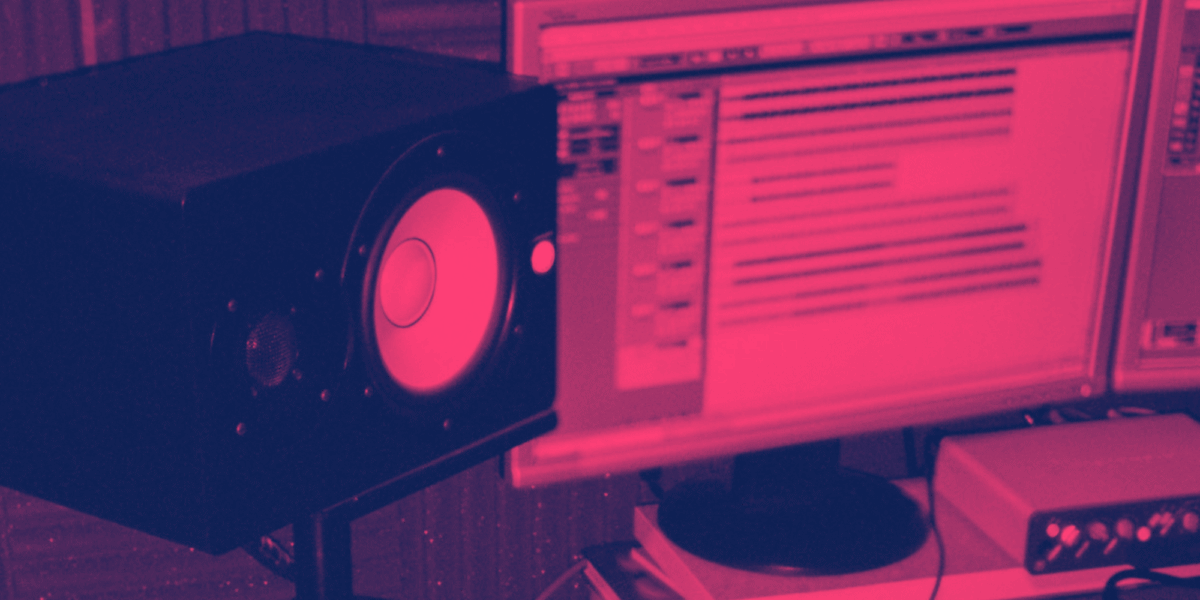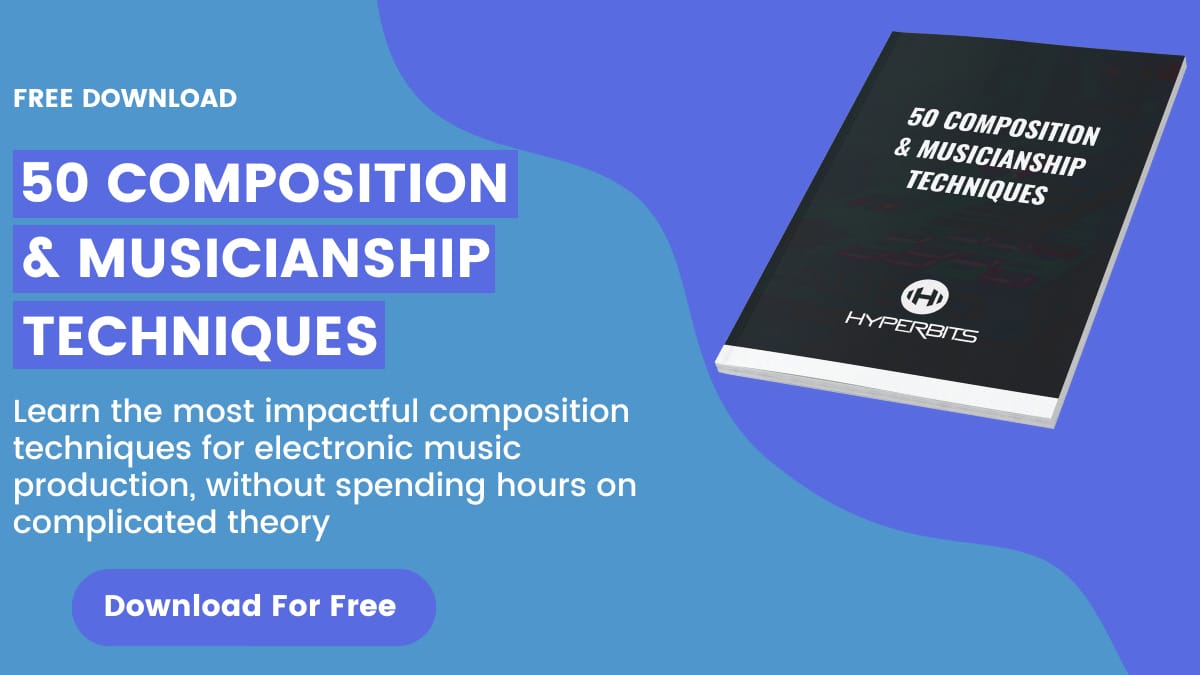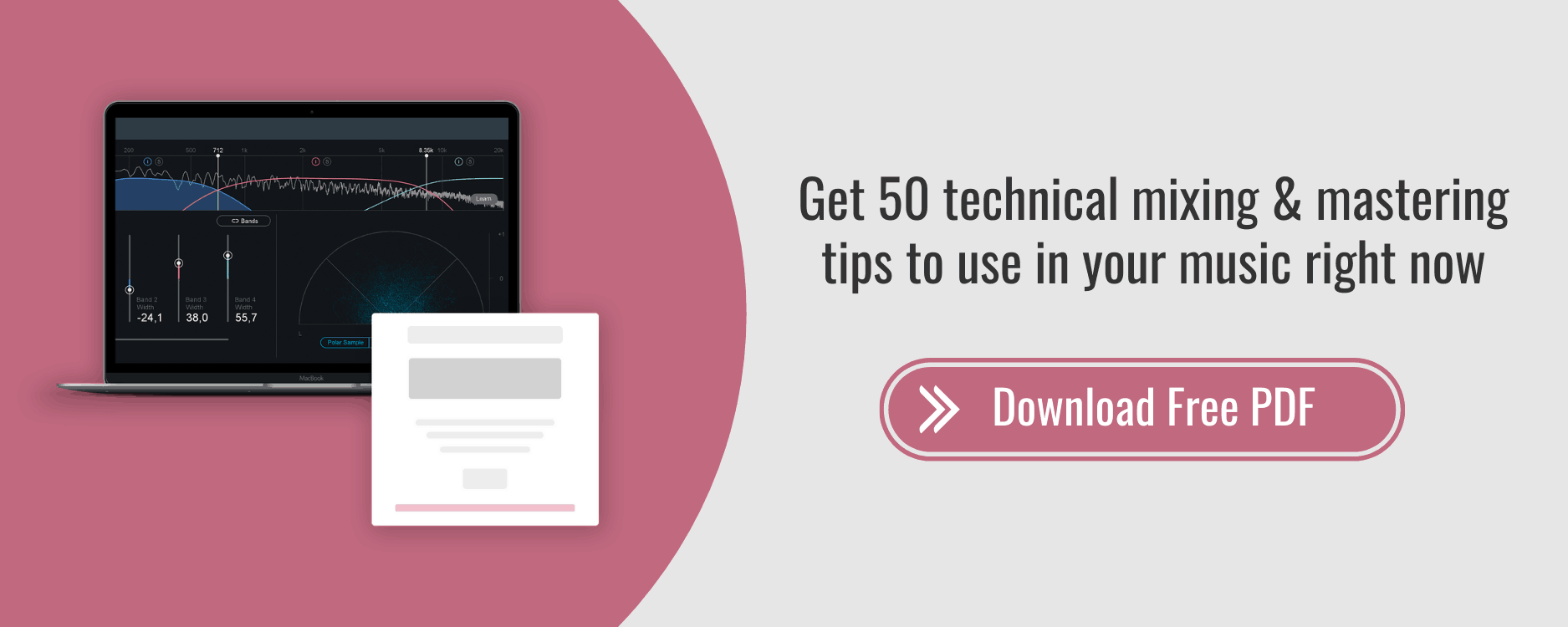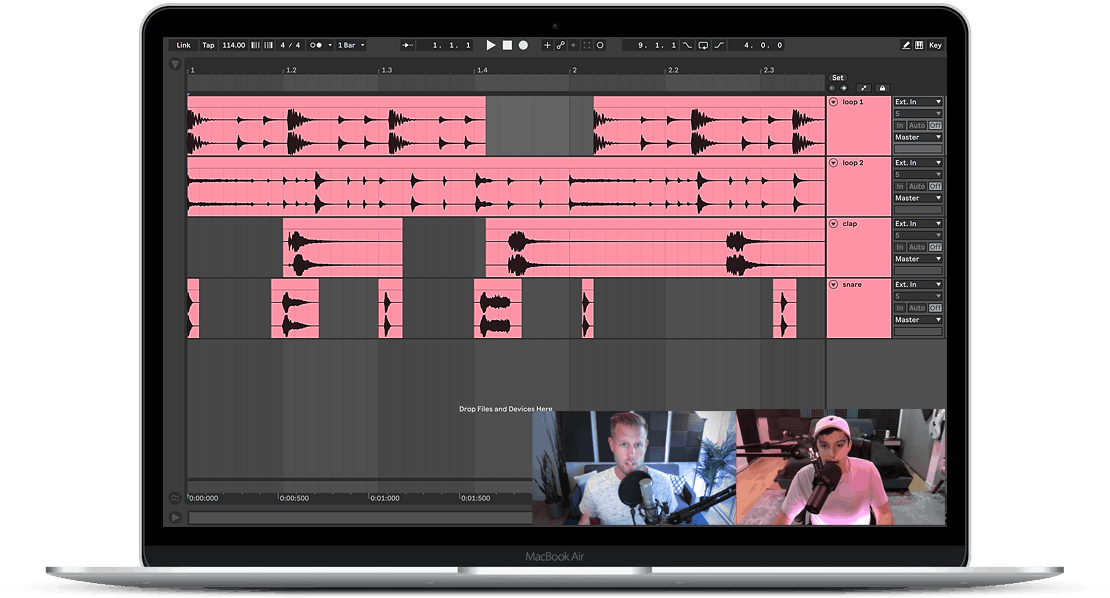Essential Guide To EDM Song Structure
"Music's exclusive function is to structure the flow of time and keep order in it."
— Igor Stravinsky
EDM song structure is at the forefront of every DJ's mind, since every track must be easy to play within an overall set. However, producers often tend to "go with the flow" and let the music dictate what should happen next.
At least the amateur ones do...
However, the professional producers have EDM song structure at the forefront of their minds. If the tracks will be supported by other big bigs and listened to on a broad scale, the songs need to make sense. From a production standpoint, conventional EDM song structure provides a narrative roadmap for the track. From a performance perspective, song structure in EDM gives the desired predictability that is sure to garner support from big-name DJs.
How Does EDM Song Structure Work?
Form always follows function in electronic dance music. Each section fulfills a specific role in the music's purpose; bringing energetic peaks and breath-catching troughs that maintain interest over an extended time. This is what makes EDM so impactful and effective on a dancefloor, the formula is simple tension and release that allows the dancefloor to go wild for the drops and catch their breath in the breakdowns.
You do not need to reinvent the wheel here. In fact, it goes directly against the ideas listed above. Dance music works because there is a certain amount of predictability, and blazing an entirely new trail will leave your dancefloor scratching their heads.
Why Is EDM Song Structure So Important?
This latter notion of predictability described above makes EDM song structure differ significantly from those more conventional genres you hear on the radio. It's designed to be played seamlessly amongst other similar tracks. Professional producers must always keep their audience and listening environment in mind when producing ways (which can be hard when you rarely leave the studio).
Nevertheless, it is not enough to know how an EDM song is structured. Professional producers also understand what each part adds to the song overall and why these parts are as effective as they are.
With a better understanding of a song's anatomy, we can start to find ways to affect its conventional structure in clever ways. This is by no means reinventing the wheel, but instead playing with the expectations to catch the audience off guard in an impactful way.
So let us dig in.
Parts Of An EDM Song
The Intro
The most stripped downed section of the track would be its intro. As EDM tracks are meant to be included in a continual mix, this section (often 8, 16, or 32 bars in length) is designed for the DJ to begin syncing the two tracks playing simultaneously. The functionality of these sections often means that these sections contain little more than a kick drum, snare drum, and some secondary percussive elements.
They can be fairly monotonous to the casual listener, so many labels also release 'radio' edits of these tracks, which remove the intro entirely.
How We Make It Better: Try to establish a vibe as quickly as possible. A washed-out pedal note, a monotone lead pattern, or a defining percussive hit adds interest to your intros, unlike the stripped back and solitary drum loops popular in previous generations' house records. Having a touch of melodic content here can create those coveted "third record" moments as the melodic ideas of both records blend into one.
Vocal chops and and atmospheres make Durante’s intro section more than just a drum loop
The Verse / Main
By this point in the track, the DJ will have mixed out the previous record and wholly transitioned into the new track. From here, the core ideas of the track have a foundation to develop, though there should still be a sense of anticipation for the impending drop section.
Expect hints of the lead melody, lighter lyrical content, and subdued chord progressions to fill out this part of the arrangement.
How We Make It Better: Introducing softer synth patches, atmospheric FXs, and subtle background noises can be a great way to help fill out this sparser section of the arrangement. More subdued sound selection can make for detailed moments that still leave room for the more energetic drop sections.
The movement of Yotto’s bass makes this sparser section feel full and dense
The Build
The build is essential to EDM song structure, as it creates the tension that will be released throughout the drop. The build sections are paramount to driving the track forward and help build excitement for the impending drop. If your build makes you hold your breath, then you know you have something special.
There are numerous tricks producers can use that heightens the swelling energy of this section, but how you release that tension just as important. Whether subtly or drastically affecting things like automation, pitch, volume, filters, and the very music itself, you can create truly exciting moments on the dancefloor that single-handedly can raise your track to new heights.
How We Make It Better: It can be tempting to drop a couple of Vengeance risers into a channel and call it a day, but too many third-party FX samples will make your track lack cohesion. Instead, look for elements native to your track to use as transitional FX. Pitch bending your lead synth, reversing vocal hits, or automating the ADRS of a chord progression as a way to make transitional effects feel native to your track.
Anden uses silence and affected chords to create tension before the drop
The Drop
This most important section of EDM song structure needs little introduction. These peak moments must make people move. This is where the track will be showing its hand in its entirety as the core musical ideas are brought in full force. As such, we advise to start producing the drop first and work your way back to avoid writing yourself into a corner before the most critical section is fleshed out.
Most dance tracks have more than one drop, but each genre often has its own conventions of how a drop is arranged. Bass genres like dubstep and drum and bass often feature three varying sections that comprise the drop, each developing, expanding, and reiterating the main bass line idea. Progressive house genres feature a classic two-drop structure, with every eight-bars of the arrangement gradually introducing new layers and elements as the track builds to its climax. It is important to analyze the conventions and expectations of the genres you produce – so watch for the section on critical listening later on in this post.
How We Make It Better: It would help producers to always be looking ahead for ways to bring the energy level of your dance track up one more notch. One way to do this is with your percussion (because who said the melodies get to have all the fun in delivering your track's climax). Saving one extra layer of percussion, such as an offbeat clav or a downbeat 909 ride cymbal, can be an excellent way to drive home the final repetitions of the melody.
Syence turns the energy up to 11 by saving the off beat hi hat for the track’s final drop
The Breakdown
A good breakdown provides a momentary pause and an opportunity to reset the energy level of the track after a high-intensity drop section. These sections often remove the bass, cut back the percussion, and sometimes even fade to near silence before the energy begins to build once more. Contrast is created in these calmer sections, which make the following drop that much more impactful by comparison.
Most dance records will consist of two breakdowns, a shorter one towards the beginning and a longer one towards the middle of the track. Back in the old days (as in 2012), producers could get away with simply copying and pasting identical breakdowns for each, but many modern producers have found ways to make these calmer sections the true emotional peak of the entire track.
How We Make It Better: Use this extra space of the parsed section to introduce a new instrument, motif, or incidental melodic idea that completely changes the vibe or brings a new perspective to the track. Conventional music genres do this all the time during the bridge, and similar approaches can bring your next dance track to new heights compositionally.
Lane 8 introduces a new pattern to the breakdown which brings a fresh idea to the track
How to Analyze Song Structure
It's been said many times, but you do not need to reinvent the wheel every time you sit to write a song. The better you become at analyzing why the structure of a song is so effective, the faster you can start implementing similar approaches in your own music.
Analyzing song structure requires critical listening, which focuses entirely on the technical elements of a song. Critical listening allows us to discover how a song is put together and why that specific structure is so effective at conveying the emotion or ideas the producer intended.
Pro Tip: A great way to do this is by bringing your favorite music into your DAW and utilizing empty MIDI clips to mark the length of each section.
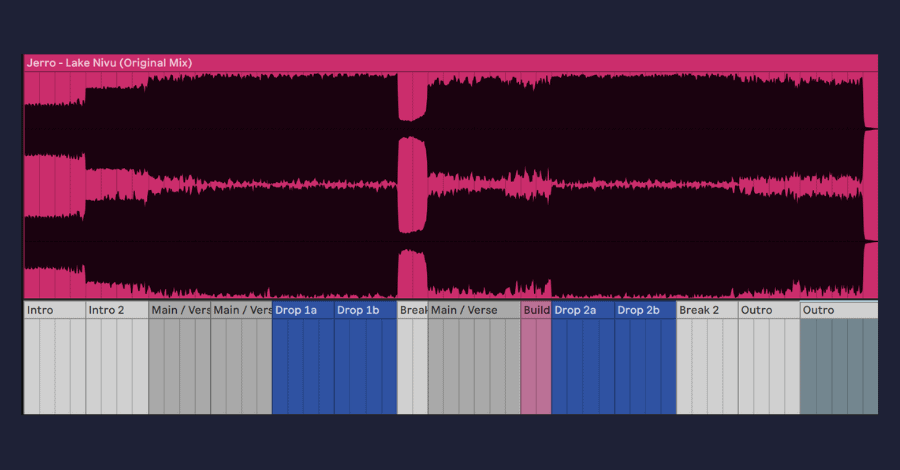
MIDI Clips block out the arrangement of Jerro's track 'Lake Nivu'
Improve the structure of your next production by asking yourself the following questions as you listen to the music of your favorite producers:
- What makes for an attention-grabbing intro section? What vibe is established right from the start?
- How does the instrumentation build anticipation for the upcoming drop?
- Does the track create tension as it shifts between sections?
- How does the song structure evolve and maintain interest from start to finish?
- What elements are removed in the breakdown? What elements continue to play?
- How substantial is the difference between the track's loudest and quietest parts?
- What are the production tricks implemented to achieve maximal impact in the drops?
Many popular DAWs allow you to take notes which you can then attach to audio or MIDI clips. Use these notes to map out exactly what is being introduced and removed throughout each section as you critically listen.

Notes and checklists keep you focused and moving in the right direction
Bonus: Turning an Idea Into a Full Song
We talk often in the Masterclass that being able to finish quality music consistently is a hallmark of a professional producer. Having a hard drive full of unfinished loops and ideas will only hold you back from the career you’ve always wanted. Use the following tips to help turn an initial loop into a fully structured dance song.
Work Backward From The Finale: Start producing the final drop first, or else run the risk of writing yourself into a corner. By establishing the peak moment early on in the process, every other decision becomes directed to this point, and the roadmap of the song's structure is made clear.
It helps that these peak moments of a track are REALLY fun to produce, and stacking extra layers to add another level of energy is always very exciting. Yet at this stage, you still don’t have a full song, and you still need different sections. Once this final drop is finished, it’s important to push through to the next stages of structuring the song or risk another 16-bar loop being added to the production graveyard of unfinished loops clogging up your hard drive.
Subtractive Arrangement: Fill every channel in your entire project with content. This 30-second process helps push past the "loop" phase of production. Now begin chipping away at the blocks of material filling your DAW's timeline. You will know you're finished by listening to the wisdom of Antoine de Saint Exupery, who said, "Perfection is achieved, not when there is nothing more to add, but when there is nothing left to take away."
It is important to note that not everyone will find use in this approach. While there are some downsides to the subtractive arrangement method, the leading benefit is that it fast tracks the production process and gets you from a simple loop into a full song fast – which is a major hurdle for many producers.
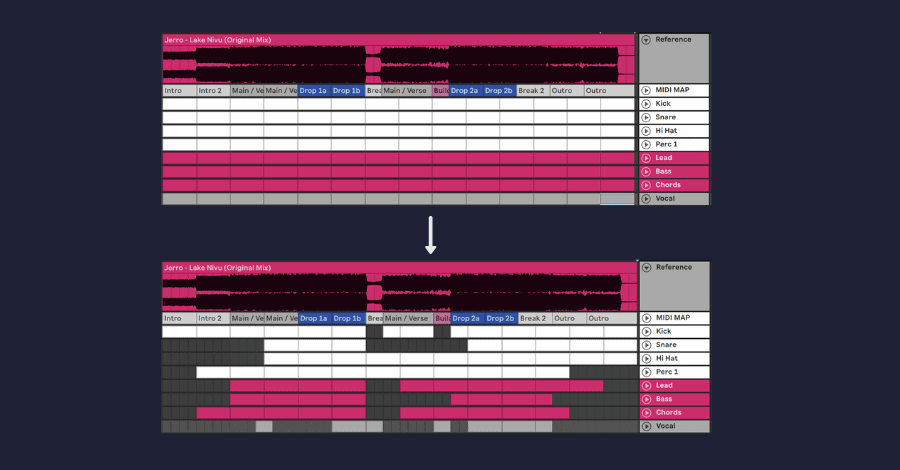
A basic structure is established quickly through subtractive arrangement
One Melody / Many Variations: Composing a catchy melody is damn hard, so after you have a good one locked in, allow your sound selection to do the rest of the heavy lifting. Handing off the melody to increasingly more energetic instruments can keep a simple melody sounding fresh over a long period. Sometimes simply adjusting the attack is enough to mellow out an aggressive lead patch for the verse and breakdown.
Modulation is Key: EDM song structure thrives on infectious repetition. A professional producer is continually looking for opportunities to modulate their sounds to maintain interest. The embedded examples of the previous section all include great examples of how professional producers change their sounds over the course of a single track.
Reference Tracks: We might sound like a broken record here at Hyperbits HQ, but reference tracks are the secret sauce that makes every part of your music better. Use them!
Final Thoughts on EDM Song Structure
Music production is damn hard, and we producers are continually having to juggle hundreds of decisions at once. But song structure should never be one of them.
Understanding the How's and Why's of EDM song structure can make this essential part of the production become second nature, but you still need to put in the hours in the studio and develop a critical ear.
With so much bad information out there, this process can be much longer than it should. That is why we built The Hyperbits Masterclass in the first place – as a singular resource that gets you producing music that's as good, if not better, than the artists you look up to. With in-depth modules on theory, arrangement, artist breakdowns, and more, Masterclass alumni develop the confidence to essentially conquer every facet of dance music in as little as 8-weeks.
These Might Also Interest You:
7 Ways to Write Better Melodies: Techniques & Rules
The Ultimate Guide to Starting Songs: 22 Foolproof Techniques to Crush Writer’s Block



